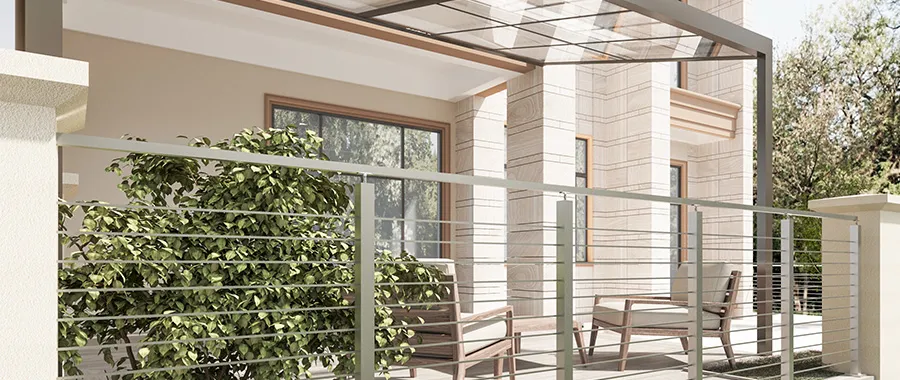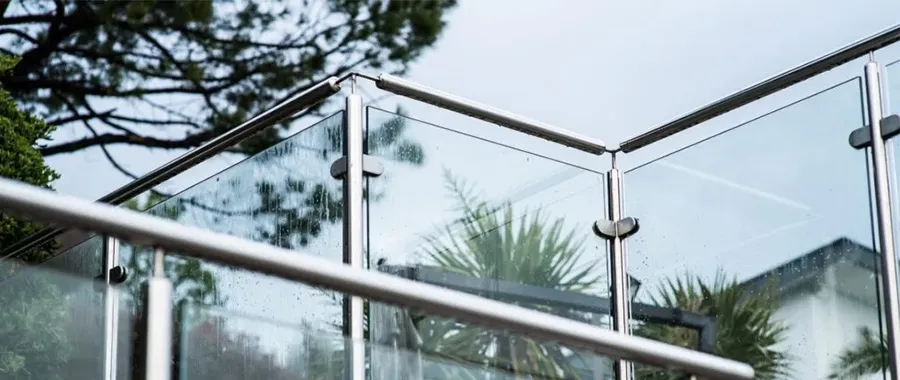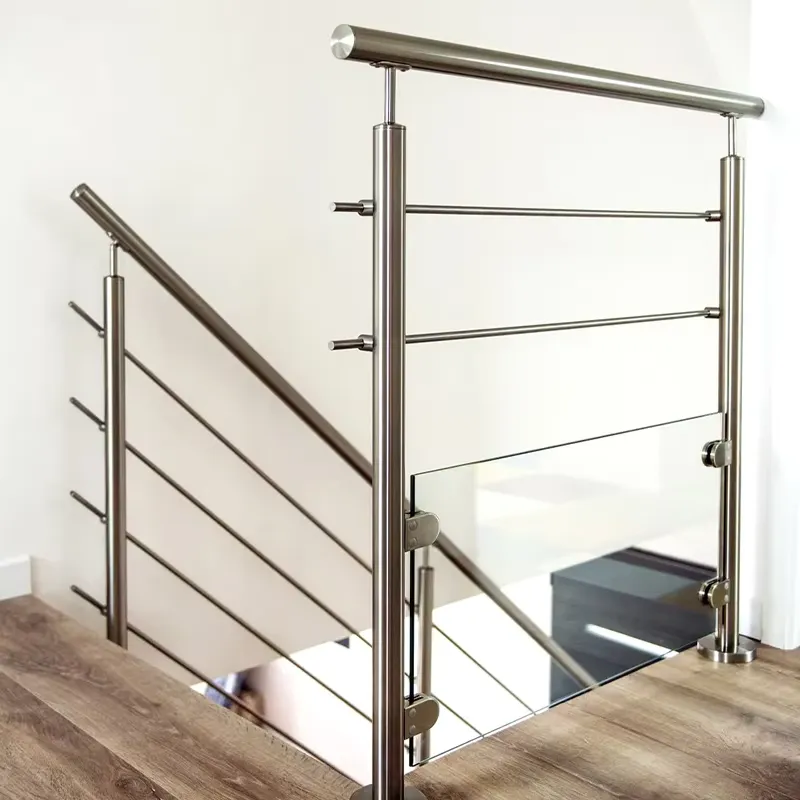Many buyers feel lost when choosing a stainless steel grade for stair railings. Using the wrong type can cause rust, maintenance headaches, or expensive replacements.
304 stainless steel is ideal for most indoor stair railings. For harsh or outdoor environments, 316 or duplex stainless steel offers the best corrosion resistance and durability.
If you are choosing stair railings, you need to know which steel fits your site and budget. I will share my experience from many real projects and break down the choices, so you get it right the first time.
When it comes to stair railings, there are so many materials and designs—glass, cable, tube, wood, or painted steel. Choosing the wrong type will lead to safety issues, extra repairs, and unsatisfied clients.
En best stair railing is the one that matches the project’s code, climate, and installation needs. For most commercial projects, modular stainless steel with glass or cable infill is the top choice.

The definition of “best” for a stair railing is not universal. For me, every project starts with three basic questions: Where will it be used? Who will use it? How much care can the owner give it?
If a railing is installed in a hotel lobby, design and cleanliness come first. For a warehouse or subway, strength and speed of installation win.
Some of my clients ask for wooden rails because they like the warmth, but then they realize wood needs repainting and is not strong enough for heavy use. I had a case where we replaced dozens of wood-and-mild-steel rails in a shopping mall after just two years because of loose joints and chipped paint.
This combination is now common in modern hotels, shopping centers, and upmarket offices. Stainless posts (often 304 or 316) support toughened glass panels.
Advantages:
Disadvantages:
These are favored in modern homes, outdoor decks, and offices wanting a “light” or industrial style.
Advantages:
Disadvantages:
This is my top pick for tough environments: public transport, factories, outdoor stairs.
Advantages:
Disadvantages:
Often used in homes or offices that want a softer look.
Advantages:
Disadvantages:
This is the lowest upfront cost for dry, indoor sites with a tight budget.
Advantages:
Disadvantages:
| Railing Type | Best Use | Pros | Cons | Usual Material |
| Stainless + glass | Hotels, malls | Modern, easy clean | Higher glass cost | 304/316 |
| Stainless cable | Homes, decks | Airy, light | Needs tensioning | 304/316 |
| Solid tube/bar | Industry, public | Strong, durable | Heavier, more welding | 304/316/2205 |
| Wood + steel | Homes, offices | Warm, easy source | Needs wood care | Wood + 304 |
| Painted mild steel | Budget indoor | Cheap upfront | Rust, chips paint | Q235 + paint |
My tip: Always ask—does your client care more about looks, or does the site need tough and low-maintenance materials? The right answer saves money and trouble later.
The price of stainless steel is one of the first things everyone asks. But it’s not just about the metal—processing and finish matter too.
Raw 304 stainless steel costs about USD 2.0–3.0 per kg. Once cut, polished, and packed as railing, the price can reach USD 5–12 per kg.
304 stainless steel is a global commodity. The market price moves daily with nickel prices, supply, and demand. But the price you pay for a finished stair railing is much more than just the base metal.
The base price for 304 stainless coil or tube is usually USD 2.0–3.0/kg. If you order large tonnage, direct from the mill, you get closer to the low end. Smaller, custom shapes or polished tubes cost more.
Cutting, drilling, welding, and forming add labor cost. My workshop uses automated saws and welding robots for big orders, but custom jobs with many joints, curves, or fancy brackets are done by hand. This can double or triple the labor cost per kg.
Finishing makes a big difference. Satin finish (brushed, 180#–240#) is most common and easiest to maintain. Mirror polish takes much more time and skill—expect to pay at least 30% more for this. If the site is outdoors or in a high-traffic area, satin is practical and hides fingerprints.
End caps, brackets, fasteners, and base plates are all extra. If you want branded or custom hardware, costs increase. For many clients, I suggest standardizing on common parts to cut cost.
For export, every railing kit is checked, packed with foam and wrap, and boxed or crated. This usually adds $0.5–1.0/kg depending on order size and packing requirements. For ocean freight, knock-down kits (parts disassembled) are cheaper to ship and avoid damage.
| Cost Item | USD/kg | % of Total | Notes |
| 304 tube | 2.5 | 30% | Raw material |
| Labor (cut/weld) | 1.8 | 22% | CNC, welding |
| Polishing | 0.9 | 10% | Satin/mirror |
| Hardware | 0.6 | 7% | Screws, plates |
| Packing/QC | 0.7 | 8% | Carton, inspection |
| Margin/Overhead | 2.2 | 23% | Management, profit |
| Total | 8.7 | 100% |
Small, custom runs cost more per kg than bulk standard orders. Tooling for odd profiles or tiny runs can add hundreds of dollars just for setup.
How to Save:
In summary, always ask your supplier for a full breakdown. Don’t compare per-kg prices unless you know what’s included—otherwise, you risk hidden costs or a product that doesn’t match your need.
Many people believe stainless steel never rusts. This is not true. Wrong grade, poor finish, or harsh conditions can still cause rust.
Stainless steel can rust if the passive layer is damaged or the wrong grade is used. Good cleaning and correct material prevent rusting.

The term “stainless” is a bit misleading. All stainless steel forms a thin, invisible chromium oxide layer that protects the metal from rusting. If this layer is damaged or contaminated, rust can form, especially in tough environments.
I have visited projects where handrails near pools or on coastal balconies developed ugly brown stains in just a few months. Usually, it was because a low-grade (like 201) was used, or the welding wasn’t finished and passivated properly.
Let’s look at the most common reasons for rust on stainless steel railings, and how to prevent it.
The most frequent cause of rust is using the wrong stainless steel grade. 304 is great indoors, but in outdoor or marine locations, it is at risk. 316 stainless contains more molybdenum, making it much more resistant to chlorides in saltwater or pool chemicals. Duplex stainless grades like 2205 are even tougher.
Welds are weak spots. If the surface around the weld is not pickled (acid-cleaned) and passivated, heat from welding can burn off the protective layer. This leaves the steel vulnerable to local corrosion. I insist all joints are finished and passivated in my own projects.
Stainless steel tools should only ever be cleaned or touched with stainless steel tools. If carbon steel brushes or grinders are used, small iron particles can stick to the surface, and these will rust—making it look like the stainless itself is corroding.
If a handrail design allows water to sit in crevices, on horizontal sections, or in base plates, the oxide layer can break down over time. Good design ensures water runs off, and base plates have drain holes.
Dirt, dust, and road salt left on stainless surfaces can trap moisture and break down the protective layer. Regular cleaning is the best and simplest way to prevent this.
| Cause of Rust | What Happens | How to Prevent |
| Low grade (201/430) | Brown stains, pitting | Use 304/316/duplex grades |
| Bad welding/passivation | Blue/brown weld marks | Always finish and passivate |
| Iron contamination | Orange spots | Use only stainless tools |
| Poor drainage | Local corrosion | Design for water runoff |
| No cleaning | Streaks, spots | Wash with soap and water |
My tips: Clean stainless steel railings with a soft cloth and mild soap. Avoid harsh chemicals. If scratches or welds occur, ask for passivation. In severe cases, mechanical or chemical cleaning may be needed.
I once managed a seaside hotel project. We used 316L railings, but the contractor installed them with tools used for carbon steel. Six months later, orange spots appeared everywhere. We had to re-polish and passivate every post. Since then, I always train installers on tool control and finish inspection.
Strength is crucial in crowded or industrial sites. Weak rails risk injuries and legal trouble.
En strongest stair railing uses thick-wall stainless or duplex steel, large anchor plates, and professional welding or bolting, anchored into concrete or steel.

A strong stair railing is not just about thick metal. The whole system—tube wall, post base, anchors, welds, and connections—matters.
On public projects, I follow strict standards. For example, many countries require railings to withstand at least 0.5–1.0 kN/m line load, and a concentrated load of 1.0 kN at any point.
In my experience, the weakest link is often not the tube but the connection to the stair or landing. Here is what I focus on to guarantee strength:
For high strength, 316L or duplex 2205 stainless steel are the best picks. Duplex is about twice as strong as 304 or 316, though it costs more and is harder to machine.
For projects with heavy traffic or where vandalism is a risk, I choose thicker walls (≥2.0 mm for posts, ≥1.5 mm for rails).
The post must be anchored firmly. I use large, thick base plates (at least 8 mm thick) with multiple anchor points. For concrete, chemical anchors or heavy expansion bolts hold much better than plastic wall plugs or small screws.
Full-penetration welds are the gold standard for strength. If you use mechanical connections, choose clamps or fittings rated for structural use. For modular systems, I always check the manufacturer’s test data.
I regularly perform pull tests on installed railings, especially on new designs or materials. Many clients request video evidence or independent test reports. Testing gives real confidence and can save a lot of trouble with inspectors.
| Railing Component | My Recommendation | Why It Matters |
| Material grade | 316L or duplex 2205 | High yield strength |
| Grosor de la pared | ≥2.0 mm post, ≥1.5 mm rail | Resists bending/dents |
| Base plate | ≥8 mm, large area | Prevents rocking |
| Anchoring | Chemical/expansion anchor | Holds under force |
| Joints | Strong welds/clamps | No slip/failure |
Case study: On a recent stadium build, we installed duplex 2205 posts with 8 mm base plates, anchored using M12 chemical anchors. The railing passed 1.5× the code load test. The project engineer later told me it was the only railing on site that had zero movement after one year of use.
For any project, always ask for supplier test reports or request a sample section for load testing on site.
Many projects focus only on initial price, not lifetime value. Cheap can be expensive over time.
Painted mild steel is cheapest at first. 201 or 304 stainless offers better value for low maintenance. 316 and duplex are costly, but best for outdoor and harsh sites.
Price is often the number one factor for many buyers, especially when working on tight budgets or public projects. But focusing only on the initial price can be risky. I’ve seen many “cheap” railings replaced just a few years later, costing double in the end.
Painted mild steel railings are usually the cheapest by kg, but paint will chip, and rust appears quickly—especially if cleaners use strong chemicals or people knock into the rails. For dry, interior environments with little traffic, mild steel can work if the owner is prepared for regular maintenance and repainting.
201 stainless steel is slightly more expensive than mild steel but resists indoor rust and needs less care. I use this grade for shopping malls and offices in dry areas, but never for outdoor or wet spaces.
304 stainless steel is the mid-range standard for indoor and some outdoor railings. The material cost is higher than mild steel or 201, but the maintenance is much lower. Satin finish hides fingerprints, and 304 holds up well if it’s not near salt, pool chemicals, or severe pollution.
316 stainless and duplex grades cost the most but last the longest. They are best for outdoor, coastal, or chemical environments. For projects with many stairs exposed to weather, I always recommend 316 to avoid problems.
The complexity of the railing design impacts cost as much as the material itself. Welded systems take more labor; modular kits are faster to install. Standardizing elbows, base plates, and post spacing can cut costs by 10–20%. For repeat projects, I often use the same jigs and modular pieces across sites, saving time and labor.
Maintenance is often forgotten when picking railings. Painted steel must be repainted every 1–2 years in busy sites. Stainless steel only needs regular cleaning. In the long run, 304 or 316 stainless often costs less over a five-year period than “cheaper” painted steel, simply because you don’t need to repair or repaint.
| Railing Material | Upfront Cost | 5-Year Cost | Best Use |
| Painted mild steel | Más bajo | High (repaint) | Dry, low-traffic interiors |
| 201 stainless | Bajo | Low-Medium | Dry indoor malls/offices |
| 304 stainless | Medio | Bajo | Most indoor/outdoor projects |
| 316 stainless | Alta | Very low | Outdoor/coastal/pools |
| Duplex 2205 | Highest | Very low | Heavy use, harsh outdoors |
Custom designs, unique brackets, or non-standard profiles always cost more per meter. I often suggest clients stick with standard designs and tube sizes for stock projects, which lets factories run larger batches and pass on savings.
My tips:
Designs, finishes, and requirements change quickly. Clients want modern looks and easy care. Codes demand safer, greener products.
Today’s trends are clean lines, matte or black stainless finishes, modular kits, and mixed materials like glass. Sustainable and smart railings are growing fast.

Stair railing design has changed a lot in the past decade. Owners and architects demand styles that match modern interiors, while at the same time, building codes are getting stricter. Here is what I see trending most right now:
Polished, shiny stainless is being replaced by satin and matte finishes. Black PVD-coated stainless or powder-coated rails are extremely popular in hotels, restaurants, and luxury apartments. They hide fingerprints and look high-end without being too flashy.
Many architects ask for railing systems with fewer visible joints and less “visual noise.” Glass infill panels with slim stainless posts or cable infill are the go-to choice. These designs open up spaces and work well in both homes and offices.
Speed of installation is now a big selling point. Modular railings are pre-cut, labeled, and sometimes even pre-assembled at the factory. This reduces onsite labor and ensures consistent quality. I recommend these kits for contractors working on tight schedules.
Combining glass, wood, and stainless steel is another trend. Glass keeps things open and modern; wood or colored accents add warmth. For safety, all glass must be tempered or laminated.
Many clients now request EPDs (Environmental Product Declarations) and want railings made with recycled stainless steel. There is also a growing interest in integrated LED lighting or IoT sensors for crowd control and safety. This is still rare, but I expect it to grow.
| Trend | Why Choose It | My Experience |
| Matte/black finishes | Modern, hides prints | More projects use black PVD now |
| Glass/stainless combos | Clean, open look | Hotel lobbies, malls love this |
| Cable/rod infill | Light, easy to install | Popular in modern offices, decks |
| Modular kits | Fast, consistent | Fewer install errors, faster finish |
| Green/smart features | Sustainability, convenience | Some clients request recycled steel |
Looking ahead: If you want your railing project to stand out or stay “future-proof,” ask your supplier about new surface treatments, prefab options, and green certificates. Smart railings with lighting and sensors will likely become standard in high-traffic spaces soon.
Choose the right stainless steel grade for safety, durability, and value. Good design and smart material selection prevent rust, lower costs, and keep your clients happy.
| Tipo | Caso práctico | Pros | Cons |
|---|---|---|---|
| Stainless+Glass | Malls, Hotels | Modern, Light | Costly Glass |
| Cable/Rod | Decks, Homes | Minimal, Airy | Needs Skill |
| Tube/Bar | Industry, Public | Strong, Durable | Heavy, Simple |
| Wood+Steel | Homes, Offices | Warm Look | Needs Care |
| Painted Steel | Budget Indoor | Cheap | Rust, Repaint |